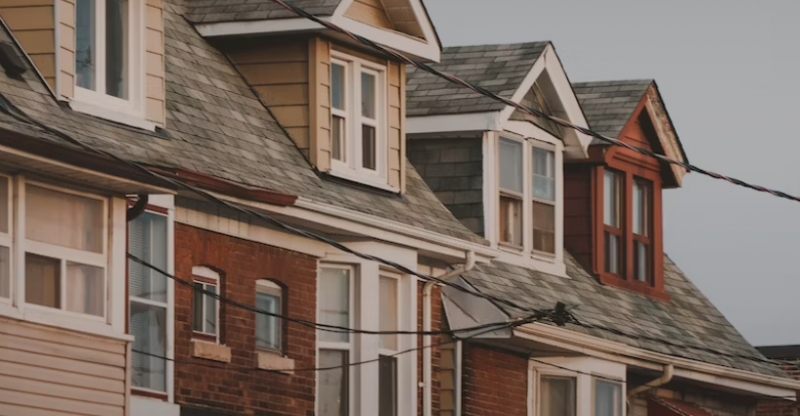Toronto Council Approves Building of Multiplexes Citywide
Toronto has bid farewell to its former housing rules that reserved large portions of the city for single-family homes.
The council voted in agreement with chief planner Gregg Lintern’s proposal to allow multiplex housing to be built citywide, granting permission for duplexes, triplexes, and fourplexes to be constructed without special permits in areas like Rosedale and Westmount, which were previously dominated by detached and semi-detached homes.
This decision marks a significant change to Toronto’s longstanding “yellowbelt,” which previously restricted approximately 70% of the city’s zoned residential land to single-family houses, resulting in concentrated growth and the skyline’s sharp contrast between low-slung houses and towering apartment blocks.
City planners in Toronto had been considering the addition of more “gentle density” housing options, such as triplexes and fourplexes, in areas dominated by single homes for several years.
The proposal was finally approved by council in an 18-7 vote. While acknowledging that it is not a cure-all for Toronto’s housing challenges, chief planner Gregg Lintern told council that the move was necessary to provide more housing options citywide and ensure that people don’t feel limited in their choices for places to live.
During the meeting, Lintern also addressed concerns about the impact on the city’s tree canopy and parking availability.
During the hours-long debate in the council chambers, some elected officials expressed concern that the proposed overhaul of the city’s planning regime would go too far. They feared that allowing multiplexes in areas dominated by single-family homes could lead to inflated land prices. Builders might see an opportunity to purchase and demolish single-family homes to construct multiplexes, leading to the displacement of longtime residents.
Additionally, some officials were concerned that suburban residents would not be happy with the changes to their neighborhoods.
However, others argued that Toronto urgently needs more housing options to prevent people from being priced out of the city they grew up in. They pointed out that the lack of affordable housing was leading to an exodus of young people and families from the city.
Multiplexes, they argued, were a viable option for multi-generational families who need more space or want to live near family members. They also pointed out that allowing more housing options would create more vibrant and diverse neighborhoods throughout the city, which would benefit everyone. In the end, after much debate, the council approved the proposal to allow multiplexes citywide, a decision that could have significant implications for Toronto’s housing market and urban landscape.
The decision to allow multiplex housing citywide in Toronto represents a significant change in the city’s planning regime, which has traditionally been dominated by single-family homes. This decision could lead to an increase in the availability of more affordable housing options, including triplexes and fourplexes, in neighborhoods where single-family homes have been the norm.
However, the decision may also lead to concerns about the potential for developers to buy and demolish single-family homes, as well as the impact on existing residents in suburban areas. Ultimately, the long-term impact of this decision on Toronto will depend on how it is implemented and how it shapes the city’s urban landscape in the years to come.
Toronto’s newly approved framework for multiplex housing is a significant shift from its previous “yellowbelt” zoning, which restricted roughly 70% of the city’s residential land to single-family homes. Under the new rules, duplexes, triplexes, and fourplexes can be built in neighborhoods across the city without requiring special permissions. This move is seen as a step towards creating more affordable and diverse housing options in Toronto, which is grappling with a severe housing shortage.
The approved framework allows for new multiplexes to be constructed up to three stories, or 10 meters high, as long as their design complements the existing physical features of the area. In areas where taller buildings are already permitted, four-story multiplexes may be possible. The new rules also allow for a multiplex to be built adjacent to a garden or laneway suite on larger lots, resulting in up to five residential units.
While some city officials have expressed concerns about the impact on land prices and suburban neighborhoods, others argue that this decision is a crucial step towards providing more affordable and diverse housing options for Torontonians. The hope is that these new rules will promote the construction of housing options that can accommodate multi-generational families, support denser development, and alleviate some of the housing affordability and availability issues facing the city.
Let’s say there is a neighborhood in Toronto with a lot of single-family homes, each with a maximum height of two storeys. Under the new framework approved by the council, builders could now construct multiplexes with up to three storeys in this area, as long as the design blends in with the existing physical features of the neighborhood. For example, the new multiplex could have a pitched roof similar to neighboring homes or be set back from the street in the same way as neighboring properties.
In areas where taller buildings are already allowed, such as downtown Toronto, the new rules could allow for four-storey multiplexes to be built. Additionally, on larger lots, the rules permit a multiplex to be built alongside a garden or laneway suite, allowing for a total of five residential units on the property.
So, the new rules allow for more housing options in Toronto, including the construction of multiplexes in areas that were previously restricted to single-family homes. By allowing for taller buildings and more residential units on larger lots, the city hopes to increase the supply of housing and provide more options for Torontonians looking for a place to live.
It is difficult to predict the exact impact of the new multiplex rules on land prices in Toronto. On one hand, allowing for more housing options may increase demand for land, which could drive up prices. On the other hand, allowing for more multiplexes may increase the supply of housing, which could lead to a decrease in prices.
Additionally, the impact on land prices may vary depending on the specific location and demand in each neighborhood. Areas that are already in high demand may see a larger increase in land prices as developers seek to take advantage of the new rules, while areas with lower demand may not see as much of an impact.
Overall, it is likely that the new multiplex rules will have some impact on land prices in Toronto, but the extent of the impact remains to be seen.
Time will tell how this decision will impact house pricing in Toronto, as it depends on a variety of factors such as supply and demand, the location of the property, and the state of the housing market. However, it’s possible that allowing multiplexes to be built citywide could increase the supply of housing in Toronto, which could potentially put downward pressure on prices if demand remains the same. Additionally, the new rules could potentially increase competition among developers, which could also have an effect on prices. On the other hand, if demand for housing in Toronto continues to outstrip supply, prices could remain high or even continue to increase despite the new rules.
Toronto has been facing a shortage of affordable housing for several years, with the city’s population growing faster than its housing supply. The rising cost of housing has made it increasingly difficult for many residents, especially low-income earners and young families, to find suitable and affordable housing. While the new rules allowing multiplexes citywide may help to increase the supply of housing, it remains to be seen how much of an impact this will have on housing prices and affordability in Toronto.





